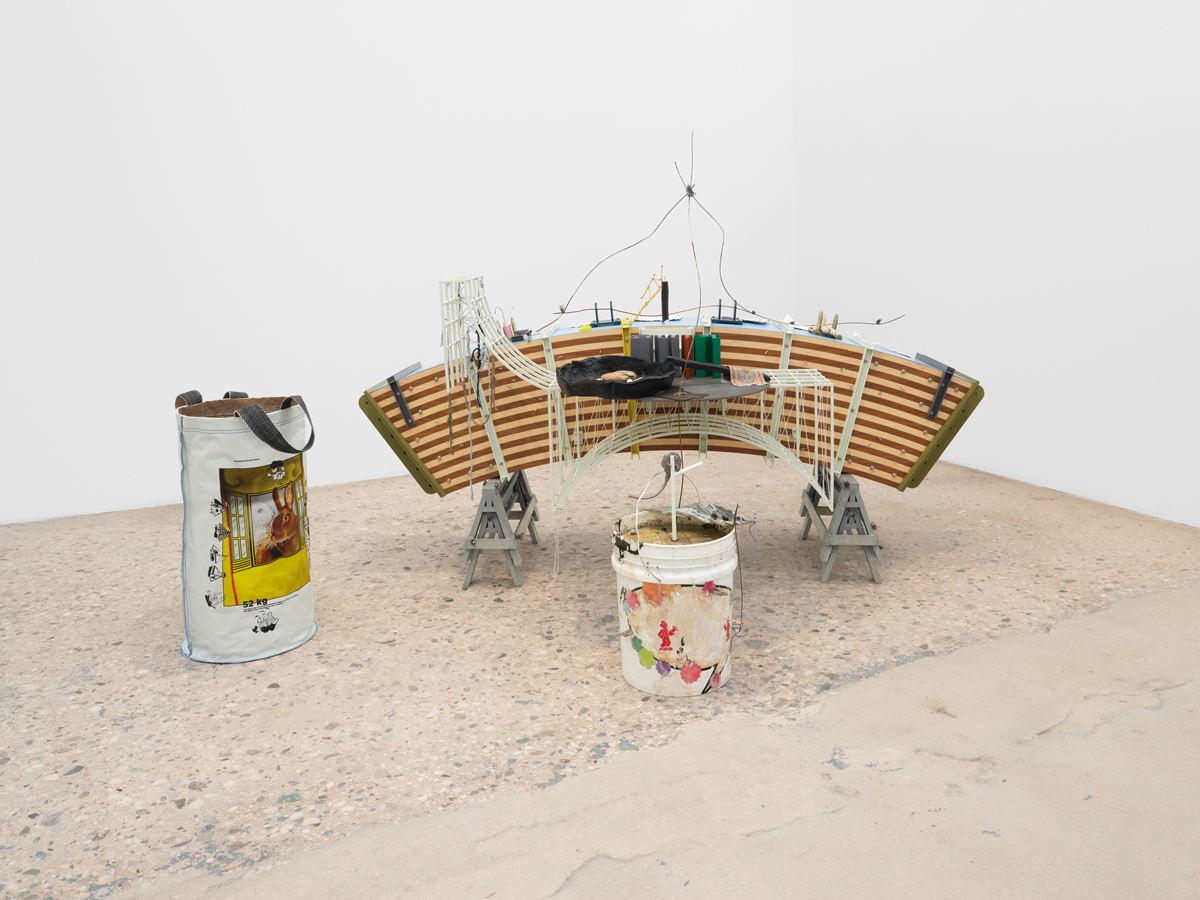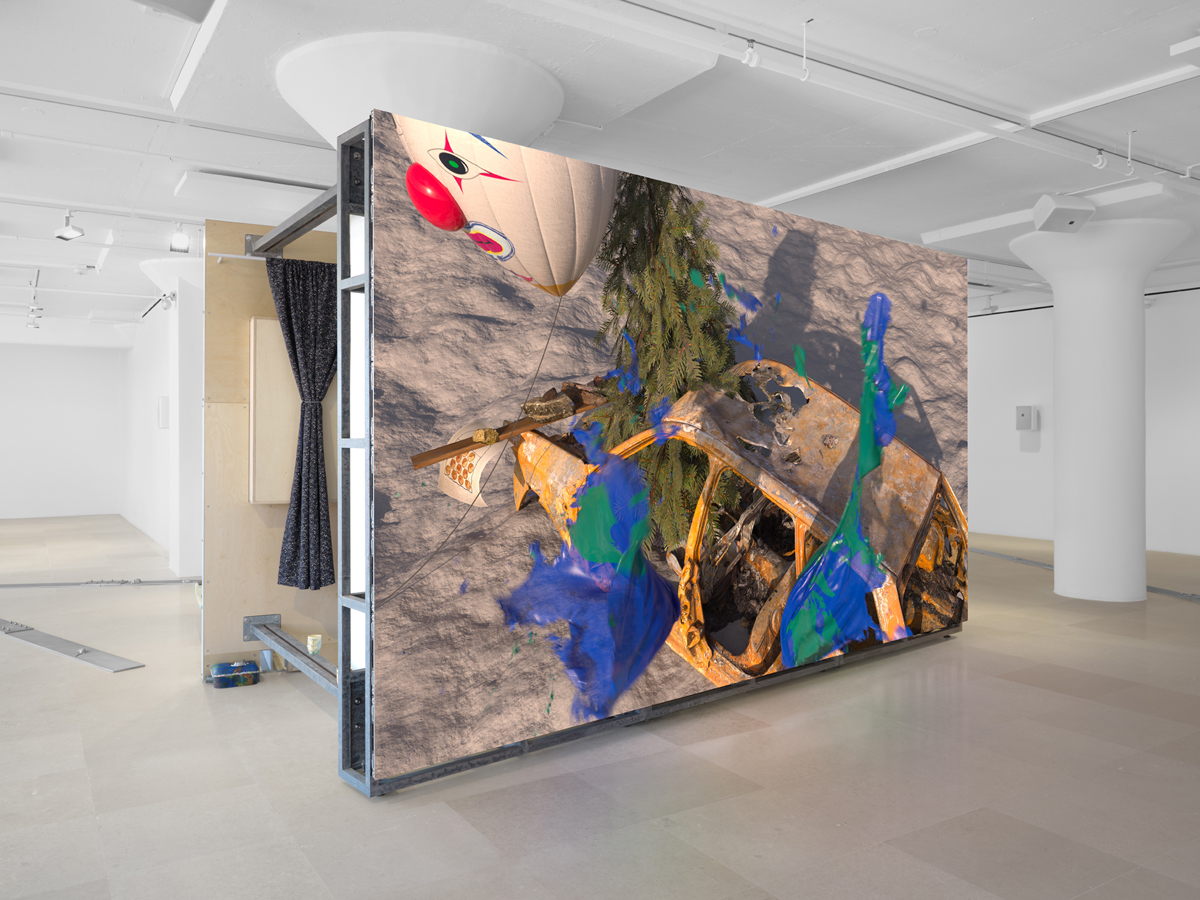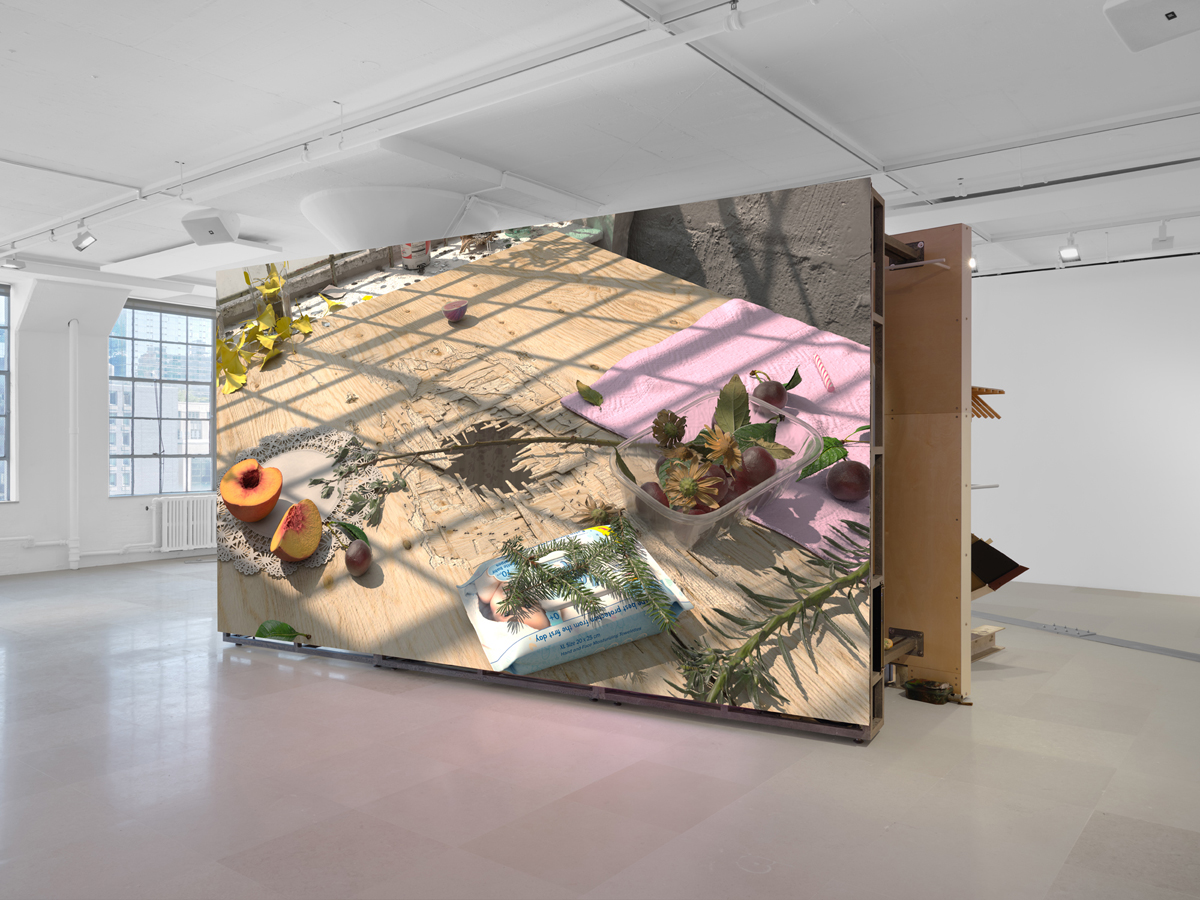 Jennifer Krasinski
Jennifer Krasinski
The Fast Seduction: an exhibition by the Turner Prize–winning artist is poison eye candy for the people.

Helen Marten: Evidence of Theatre, installation view. Courtesy the artist and Greene Naftali. Photo: Eva Herzog. Pictured, center, back right wall: The dawn reflection, 2023.
Helen Marten: Evidence of Theatre, Greene Naftali, 508 West Twenty-Sixth Street, New York City, through November 4, 2023
• • •
I am of two minds about Helen Marten’s Evidence of Theatre. There is just so much to fall for in this show of new works, and I’ve always been a sucker for a seduction plot. In one mind, I walked around Greene Naftali’s ground-floor space utterly transported by declarative-scale paintings like Hole in the World, The dawn reflection, and Speech Weavers. Their extroverted palettes, the eye-sizzling precision-rendering of their originary digital scribblings, the giddy agitations of their figures and shapes, all muscled me into unconditional surrender. Then there was the matter of the works’ deep-set frames and the thin aluminum brackets (a clever nod to stretcher bars) that Marten has arranged over their surfaces so that what we’re seeing, whether we believe it or not, lands us in the realm of the verso—the side of an artwork usually hidden, its images, if any, possibly preparatory, abandoned, or rejected. It’s a canny move to make it seem to a viewer that they’re gazing out at the world from the other side of the looking glass.

Helen Marten, There will be flowers in the end (anxiety bones), 2023. Aluminum, steel, maple, walnut, cast pewter, cast Jesmonite, cast silver, sand-cast aluminum, resin, string, wool, pistachio shells, snail shells, cardboard, steel wool, magnets, stitched fabric, PVC, hammered lead, bitumen. Courtesy the artist and Greene Naftali. Photo: Eva Herzog.
Most engaging to me were her sculptures, prodigious compositions of motley objects both found and forged. Those that are freestanding, such as There will be flowers in the end (anxiety bones), felt like sets (or props) from spun-out plays—but only felt like, as suggested by the show’s title. Her work never stoops to be, exactly, embracing instead a yes, and approach to form that bucks narrative and leaves viewers in an intoxicating state of semiotic limbo. Example: Modern Sluice presents an oddball piece of furniture—or an immovable, improbable vehicle, or, or, or—on which sits a paper hat, rendered in fact in metal, filled with a milky-white substance in which the letters s, l, u, i, c, and e are suspended. The title’s source is clear, but all else is up for grabs. Other assemblages are appended to panels, some set behind paintings, combines that also upend one’s sense of recto/verso, here/there, by way of the third dimension. Materially promiscuous yet conceptually taut, these works make it crystal clear why Marten was awarded Britain’s Turner Prize in 2016, when she was thirty-one, becoming its youngest recipient.

Helen Marten, Modern Sluice, 2023. Aluminum, steel, cross-sawn oak, glazed ceramic, paper, fabric, model board, cast Jesmonite, cast pewter, resin, birdseye maple, nylon inks. Courtesy the artist and Greene Naftali. Photo: Eva Herzog.
My second mind, however, soon wearied of the dazzle and the busyness, grew wary of Marten’s invocation of theater—which she defines in an essay accompanying the show as not only those fictions presented on a stage but also those constructed politically, publicly, and socially—which quickly felt more theatrical than revealing. What is the appropriate gravitas with which to receive a discourse on the semiotics of stuff and the nature of reality via objects glamorous, rare, and expensive? I took a cue from Sigmund Freud, the dramatis persona in a series of very funny vintage Corn Flakes ads in which the psychoanalyst champions the breakfast cereal as the cure-all for all kinds of psychological ills. Marten deploys these ads on some of her panels, presumably to poke a hole in the absurd claims of commercialism. (For a deeper dive into Freud and his influence on twentieth-century advertising, see Adam Curtis’s 2002 documentary series The Century of the Self.) As the good doctor “says” in one, “you can un-split a ‘split personality,’ ” but I decide to keep my two minds running in tandem. (Regarding deeper thoughts about how criticism and analysis are simpatico, I recline—I mean, decline to entertain them.)

Helen Marten, Evidence of Theatre (they sold), 2023. Sprayed aluminum, screen-printed aluminum, steel, cast Jesmonite, cast pewter, grapevine, handmade paper, cast plaster, metallic beads, stitched fabric, resin, oak, cardboard, hammered lead, brass bells, nylon inks. Courtesy the artist and Greene Naftali. Photo: Eva Herzog.
On the gallery’s eighth floor is Writing A Play (dark blue orchard), an installation featuring an eerie, hypnotic twenty-eight-minute CGI animation. Time: winter, post-something-or-other. Place: in and around architectures and landscapes so generic they feel familiar. Enter: no one. Like Marten’s sculptures, every scene is a composition of things—snow, birthday candles, balloons, a dead deer, a frog in flames, a raspberry, and more and more still—profoundly profane, their image resolutions high. Like poison eye candy, the video might entice you—and by you I mean me—to lick the screen, no matter how death-driven its imagery. “I am writing a play,” declares Marten’s unnamed narrator, in a voice-over performed by British actor Gwendoline Christie. She (character) is possibly a playwright, but her vocation here matters less than the mind-space she proposes: one in process, where all is proposition, is possible, and nothing is set in stone.

Helen Marten, Writing A Play (dark blue orchard), 2023. Courtesy the artist and Greene Naftali. Photo: Eva Herzog.
Distinctions between the real, the unreal, and the imagined are sometimes a bit more ham-fisted here. An early scene is composed around a window overlooking fir trees in a yard, an “I Voted” sticker stuck to the lower right corner of the glass. A cartoonish bird ornament hangs from the lintel. The word empty is scrawled above it. An owl suddenly flies into frame—its stuttering movements more fake than uncanny—smacks flat against the glass, and plummets to the ground. The ornamental bird remains in the air as we imagine the fake real bird lying on the fake ground out of frame.

Helen Marten, Writing A Play (dark blue orchard), 2023. Courtesy the artist and Greene Naftali. Photo: Eva Herzog.
“We have learned to use our eyes, and then to distrust them,” coos Christie at one point, but here it’s Marten’s words that are untrustworthy, filmy, like Vaseline on a camera lens, giving the video an artificially literary aura. “I am a pig, a peacock, a graveyard, a tiger,” the narrator incants. “I am a new doctor, an eel, steam off a toad. I am money, the moon, sickness.” Well, which is it already? you might think—and by you, I mean I, and by might think, I mean groaned. None of us needs Freud’s acumen to understand why a writer would bristle at the old language-is-material-too strategy. For visual artists, it often results in self-indulgence instead of a keen attention to craft, and in the unleashing of insufferable streams of text purporting to be radical literary acts. (Note: even Gertrude Stein had an editor). “As both producer and receiver, I feel like my only job is to turn on the tap and already that is a linguistically creative contribution!” Marten said in a 2020 interview with ArtReview.

Helen Marten, Speech Weavers, 2023. Nylon paint on fabric, stained ash, powder-coated aluminum. Courtesy the artist and Greene Naftali. Photo: Eva Herzog.
I might have felt more generous toward her words if I believed she held a certain esteem for writing, but I could not ignore the fact that Marten once took a glowing essay about her work by the mighty Nobel laureate Elfriede Jelinek, shredded it, then baked it into salt dough that she rolled into the letters D, O, and G to create a work knowingly titled I am the dog and nobody owns me (2020, not on view) in an edition of two—one for Jelinek, one for the artist. Inside the very real economic disparities between art and literature, this gesture, surely intended to be light and playful, has another, darker read: a successful young artist, having been extended a Nobel laureate’s literary credit, flexes the power of the object economy, destroying (actually and metaphorically) Jelinek’s words, which, if ever those artworks appeared on the open market, would thereafter be perceived as being more valuable than, say, the essay itself. Does a clever concept ever trump a grim reality? While I still remain both seduced by and skeptical of Marten’s Evidence of Theatre, on this question my mind’s made up.
Jennifer Krasinski is a writer and critic, and frequent contributor to Artforum, Bookforum, and more.